Quick Look
Grade Level: 10 (9-12)
Time Required: 3 hours
(60 minutes to make/find an image and create the stencil, 60 minutes to create the patch, 60 minutes to sew/install the patch)
Expendable Cost/Group: US $28.00 This activity also uses some non-expendable (reusable) items; see the Materials List for details.
Group Size: 2
Activity Dependency: None
Subject Areas: Computer Science, Science and Technology
NGSS Performance Expectations:

| HS-ETS1-2 |
Summary
Students combine art, gaming culture and engineering by fabricating light-up patches to increase youngsters’ visibility at night. The open-ended project is presented as a hypothetical design challenge: Students are engineers who have been asked by a group of parents whose children go out Pokémon hunting at night to create glowing patches that they adhere to clothing or backpacks to help vehicle drivers see the kids in the dark. Student pairs create Pokémon character stencil designs cut from iron-on fabric patches, adding transparent layers for color. Placed over an EL (electroluminescent) panel that is connected to a battery pack, the stencils create glowing designs. Each team creates a circuit, which includes lengthening the EL panel wiring to make it easier to wear. Then they sew/adhere the patches onto hoodies, messenger bags, hats, pockets or other applications they dream up. The project concludes with team presentations as if to an audience of project clients. Keep the project simple by hand cutting and ironing/sewing, or use cutting machines, laser cutters and sewing machines, if available.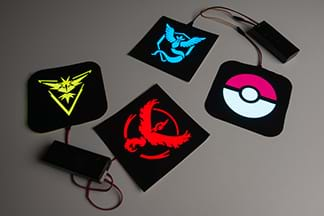
Engineering Connection
Engineering is essential to peoples’ health, happiness and safety. For example, some engineering projects improve public health, like sewer and sanitary infrastructure and water treatment plants. Some engineers work in the medical field to design replacement limbs and medical technology. Other engineers create GPS electronics that help emergency personal locate lost and injured hikers. In this fashion, like real-world engineers, students create devices that improve people’s safety at night by creating light-up patches for Pokémon Go players.
Learning Objectives
After this activity, students should be able to:
- Use technology components (wire, battery, EL panel) to make a functioning project, including soldering.
- Define what electroluminescent (EL) patches are.
- Explain the components of a circuit with EL patches.
- Explain how engineers are essential to human safety.
- Demonstrate the interaction between engineering and the arts.
Educational Standards
Each TeachEngineering lesson or activity is correlated to one or more K-12 science,
technology, engineering or math (STEM) educational standards.
All 100,000+ K-12 STEM standards covered in TeachEngineering are collected, maintained and packaged by the Achievement Standards Network (ASN),
a project of D2L (www.achievementstandards.org).
In the ASN, standards are hierarchically structured: first by source; e.g., by state; within source by type; e.g., science or mathematics;
within type by subtype, then by grade, etc.
Each TeachEngineering lesson or activity is correlated to one or more K-12 science, technology, engineering or math (STEM) educational standards.
All 100,000+ K-12 STEM standards covered in TeachEngineering are collected, maintained and packaged by the Achievement Standards Network (ASN), a project of D2L (www.achievementstandards.org).
In the ASN, standards are hierarchically structured: first by source; e.g., by state; within source by type; e.g., science or mathematics; within type by subtype, then by grade, etc.
NGSS: Next Generation Science Standards - Science
| NGSS Performance Expectation | ||
|---|---|---|
|
HS-ETS1-2. Design a solution to a complex real-world problem by breaking it down into smaller, more manageable problems that can be solved through engineering. (Grades 9 - 12) Do you agree with this alignment? |
||
| Click to view other curriculum aligned to this Performance Expectation | ||
| This activity focuses on the following Three Dimensional Learning aspects of NGSS: | ||
| Science & Engineering Practices | Disciplinary Core Ideas | Crosscutting Concepts |
| Design a solution to a complex real-world problem, based on scientific knowledge, student-generated sources of evidence, prioritized criteria, and tradeoff considerations. Alignment agreement: | Criteria may need to be broken down into simpler ones that can be approached systematically, and decisions about the priority of certain criteria over others (trade-offs) may be needed. Alignment agreement: | |
International Technology and Engineering Educators Association - Technology
-
Design problems are seldom presented in a clearly defined form.
(Grades
9 -
12)
More Details
Do you agree with this alignment?
-
Use computers and calculators to access, retrieve, organize, process, maintain, interpret, and evaluate data and information in order to communicate.
(Grades
9 -
12)
More Details
Do you agree with this alignment?
-
Illustrate principles, elements, and factors of design.
(Grades
9 -
12)
More Details
Do you agree with this alignment?
-
Use various approaches to communicate processes and procedures for using, maintaining, and assessing technological products and systems.
(Grades
9 -
12)
More Details
Do you agree with this alignment?
State Standards
Colorado - Science
-
Gather, analyze, and interpret data to describe the different forms of energy and energy transfer
(Grade
8)
More Details
Do you agree with this alignment?
Materials List
Each group needs:
- EL (electroluminescent) panel, white, 10 x 10 cm (~3.9 x 3.9-inches), from Amazon; this is a flexible plastic sheet with a phosphor layer that lights up with a neon-like glow when the correct amount of voltage is applied
- iron-on fabric patch, 5 x 5-inch piece (needn’t be bigger than EL panel size); needs to be thick enough to block the light from the EL panels, such as denim or twill patches from a fabric store; alternatively, create your own using an iron-on adhesive with your own fabric, such as by using Heat’n Bond Ultra Hold iron-on adhesive (17 x 12 inches) from Amazon
- clothing or bag—something to put the patch on that will be worn at night, such as a hoodie, jacket, backpack, bag or hat; make sure it has enough area for the patch and can be ironed without melting; items made of leather, waterproof fabrics and nylon are not recommended; ask students to bring items from home in advance or buy inexpensive items at second-hand stores
- 4-6 pieces of heat shrink, each ~1 inch, such as from the heat shrink kit from SparkFun
- EL (electroluminescent) inverter battery pack, from Amazon
- (2) 1.5V AA alkaline batteries, such as the 1500 mAh alkaline AA battery from SparkFun
To share with the entire class:
- craft knives, 4-5 per class of 30
- (optional) binder clips, paperclips or clothespins, to secure the paper design onto the fabric for cutting
- (optional) a piece of cardboard the size of the fabric patch, to protect the tabletop when cutting with a craft knife
- (optional) sharp/strong scissors, to help cut the stencil and/or cut the EL panel (if necessary)
- lighting gel or colored plastic, in assorted colors such as a set of 8 from Amazon, to add color to stencil designs; alternatively, provide thin colored fabric or felt that can handle the heat from an iron
- (optional; if using laser cutter) scrap cardboard and clear tape, for securing and easy removal of the patch fabric in a laser cutter
- electrical tape
- (optional) a way to insulate newly soldered exposed wire connections and/or to seal exposed edges if EL panels are cut, such as by coating in epoxy, hot glue or electrical tape
- iron; a small, wand-style craft iron or mini iron works best because it can get into detailed areas of the fabric’s cutout design without directly touching the EL panel, such as the Clover Mini Iron from Amazon; using the hot pointed tip of a “regular” clothing iron also works
- ribbon cable, cut into 1-foot pieces, such as 15 feet of 6-wire ribbon cable from SparkFun
- sewing supplies, such as scissors, needles, thread
- (optional) sewing machine
- soldering iron and solder
- safety glasses, for when soldering
- wire cutters
- wire strippers
- paper and pencil, to draw stencil designs
- (optional) computers with Internet access, to find existing public domain vector line drawings of logos and images to print out (otherwise, students draw their own designs)
- (optional) heat gun, for use with heat shrink
- (optional) cutting machine, such as Silhouette or Cricut personal cutting machines or laser cutters
- (optional) graphics/drawing software such as Adobe Illustrator®, CorelDraw® or (free and open source) Inkscape (a vector graphics editor) to trace an image and export for cutting machine use
- (optional) glue, if the iron-on patches need some extra adhesive
Pre-Req Knowledge
Students should have basic hand-sewing skills, be able to solder, and have a basic knowledge of circuits. For the latter, refer to the Circuits lesson.
Introduction/Motivation
How many of you know of or play the Pokémon Go game on your phones? (Expect many students to raise their hands.) Games like this are especially fun since you get to interact with objects in the game as you walk around your neighborhood. The game designers combined real-world locations with game-world events. It takes engineers working with sensors and electronics to make games like this possible. But the engineering doesn’t stop there! Engineers are essential to our health and safety, and they design products to help you stay safe while you’re out at night Pokémon hunting.
In this project, imagine that you are engineers who have been contacted by a group of parents whose children love to go out Pokémon hunting at night. The parents are concerned that vehicle drivers won’t see their children very well in the dark, so your team has decided to create light-up patches to help the young Pokémon trainers stay safe and visible at night. To do this, you will add a cloth stencil over EL panels to create glowing team logos and designs. EL is short for electroluminescence; when connected in a circuit, the EL panel lights up without getting very hot, which makes it ideal for sewing and ironing onto fabrics.
Use your imagination—what clothing or other wearable items would kids want to wear while playing Pokémon Go in the dark? Are you ready to create products that will help kids stay safe during their Pokémon adventures? Let’s get started!
Procedure
Stencil Prep and Cutting Tips
For this project, students cut out their stencil graphics from iron-on fabric patches using either craft knives—or a cutting machine if available. They may draw by hand their own graphic images/logos or find existing public domain graphics from online searches. A good way to make simple yet fun cuts without a machine is to fold the stencils in half and cut triangles and odd shapes as if making paper cutout snowflakes!
To cut by machine, a vector line drawing of the image/logo is needed. These are often provided in svg or ai format, which may or may not be a format directly accepted by your cutting machine. See below for some special considerations for different machines. Another approach is to have students use graphics/drawing/vector editing software to trace an image and export it to the cutting machine.
In all cases, advise students to adjust the cut lines of their graphics (or choose graphics carefully) so that enough fabric remains between cuts so that it won’t tear or warp when removing it from the cutting surface or when working with it later to attach/install/sew it.
Cutting Machine Tips
Silhouette Machines: It is only possible to import svg files into Silhouette software by upgrading to Silhouette Studio® Designer Edition. This premium software permits the import of files directly from Adobe Illustrator® or CorelDraw®. You can also download a plug-in called Silhouette Connect™. Alternatively, if you do not want to upgrade the software, you can also export your files as dxf and import them in that format. Additional Silhouette resources:
- Viewing and Using .DXF files in Silhouette Studio tutorial by Inspire Graphics
- File Types Silhouette Studio® Can Cut reference by Silhouette
Cricut Machines: Cricut machines use web-based software called CricutDesignSpace, which can import both svg and dxf files, but they may need some clean up before use.
Tip: Newer cutting mats can be sticky and transfer some adhesive to fabric. So be careful when removing fabric from the mat not to tear or warp the fabric. Using the specialty spatula tools that come with the machines helps to remove small parts of the cut without damaging the fabric.
Laser Cutter: If using laser cutters, have students import their vectors as they would any other print. Use some clear tape to attach the fabric to a piece of scrap cardboard to make it easier to remove the stencil from the bed.
Tip: It may be necessary to adjust the graphics to avoid small areas where strain may tear the fabric. In the Figure 1 example, the spaces between stencil parts were too narrow and tore when removed from the machine. Practice on a test piece of fabric first.
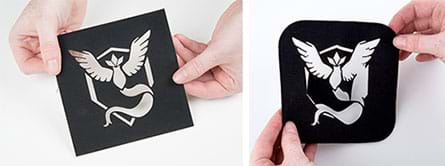
Soldering Background
How to Solder: Through-Hole Soldering tutorial by SparkFun at https://learn.sparkfun.com/tutorials/how-to-solder-through-hole-soldering. Soldering two wires together is like through-hole soldering; twist the two wires together then apply solder to permanently connect them. Applying heat shrink over the connector protects and insulates it, and prevents accidental shocking.
Before the Activity
- Gather materials. Have students bring in their own clothing/hats/bags, see the Materials List.
- If using a cutting machine, practice creating a few stencils as examples to show students.
With the Students—Project Introduction
- Conduct the pre-activity engineering-for-safety discussion, as described in the Assessment section.
- Kick off the activity and its design project by presenting to the class the Introduction/Motivation section.
- Organize the class into student pairs.
- Distribute materials.
With the Students—Preparing the Stencil
- To begin, have each group create or obtain a stencil design that is no bigger than the EL panel.
- Have students either draw their own designs on paper or conduct an online browser image search for “Pokémon GO team logo vector,” to find files created by others who have made them available to download (and print out) for free.
- Suggest they make the stencil a maximum of ~3.75 x 3.75-inches.
- Supervise teams as they cut out their stencils.
- This involves putting the graphic design on an iron-on fabric patch and cutting it out using either craft knives (be patient and careful!)—or a cutting machine, if available. Before using a craft knife to directly hand cut the design, secure the paper design onto the fabric with binder clips (or paperclips or clothespins), then place these layers on a piece of cardboard to protect the tabletop while cutting.
- Advise students to adjust the cut lines for their graphics as necessary to leave enough fabric between cuts so that they don’t tear or warp when removing them from the cutting surface (see Figure 1) or when handling them later to install/attach.
- If cutting on a machine, a vector line drawing of the logo/image is required, which can be found from a browser search, by using graphics/drawing software to trace an image (make it into vector form that cutting machines can read) and export it to the cutting machine, and/or by directly creating a design in a graphics/drawing application.
- If using Adobe Illustrator, refer to a 1:18-minute How to Convert Image into Vector Graphics with Adobe Illustrator CS6 tutorial. Or, draw the design directly in Adobe Illustrator and save it as an ai or eps vector file.
- If using (free, open source) Inkscape, a vector graphics editor, find and save an online image. Then, in Inkscape, select File > Import and select the image file. The image shows up as a red X. Next, go to View > Display > Normal. Use the cursor to draw a box around the entire image, then go to the top and select Path > Trace Bitmap. For more detailed instructions (with visuals) on converting images to be vectors in Inkscape, refer to the How to Vectorize in Inkscape tutorial.
- Work with students to get their graphics into a format that can be directly imported into your cutting machine software. Refer to the tips at the beginning of the Procedure section for considerations for each machine.
With the Students—Attaching the Stencil
- Tell students that next they are going to adhere the stencils to the EL panels. To begin, have students remove and discard the thin plastic sheet that covers and protects the light-up side of the EL panel (see Figure 2).
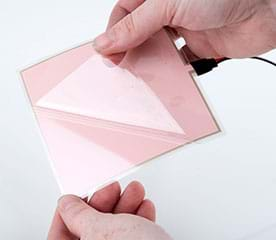
- If student designs require different colors or multiple colors on one El panel (see Figure 3), suggest the following techniques to layer in another material. Using a white EL panel as the base layer gives the best color results.
- Cut a piece of lighting gel (or colored plastic) that is slightly larger than the holes to be colored in the design but smaller than the edge of the El panel (see Figure 3-left).
- Alternatively, place a thin piece of fabric or felt under the design and iron it in place (see Figure 4).
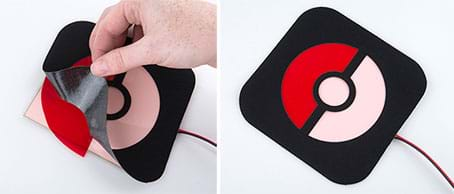
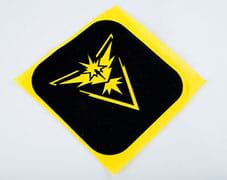
- Next, direct the groups to carefully line up the stencil on the colored side of the EL panel, centering and adjusting as needed. Important tips to tell students:
- Once final placement of the cutout patch stencil design and any color layers is achieved, place a hot craft iron on the patch, moving it in small circles to melt the adhesive on the fabric, as shown in Figure 5.
- If using a “regular” clothing iron, put it on the cotton setting and use the hot pointed iron tip while carefully avoiding touching the EL panel.
- Do not iron the fabric patch material that extends beyond the EL panel because that adhesive is needed to iron the patch onto the clothing or pack item later.
- Use the iron quickly and avoid directly touching the EL plastic. It is better to make a few passes than hold the iron in place for too long. Use the point of the small iron-shaped head to get into the cutout corners without touching or overheating the EL panel.
- As you iron, check the adhesive every so often by carefully trying to peel up the fabric edges.
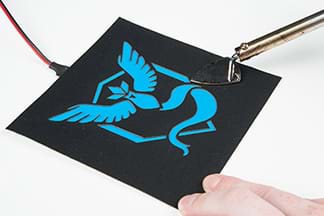
With the Students—Adding Extension Cables
- Tell students: The wires that come attached to the EL panels are pretty short, which can be limiting when you want to place the battery pack to make it wearable. So we are going to make and insert an extension to the cable to free you up to place the EL panel further away from the battery pack (as shown in Figure 6).
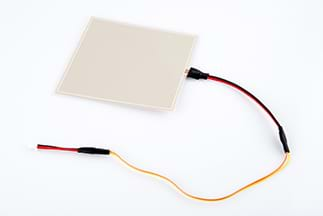
- To begin, make sure the EL panel is disconnected from the battery pack.
- Let students choose how much of a wire extension to add to the EL panel, which they cut from the 15-foot length of 6-wire ribbon cable. As an example, the Figure 6 example adds about 8 inches. Tell them to measure two equal lengths of wire to use as the extension wiring, adding additional length to ensure enough slack, as needed. Tell students to split the 6-wire ribbon cable pieces into 2-wire pieces by carefully peeling two wires away from the rest.
- Have students prepare the EL panel wires for soldering by cutting them midway between the EL panel connection and the JST connector.
- Have students strip the ends of all wires, cut some heat shrink into ~1-inch pieces (enough to cover the exposed wire) and feed it over the wire away from the soldering area before they begin soldering. Later, they will slide the heat shrink over the soldered connection to protect it. (If students want to further shrink wrap over both shrink-wrapped wires to provide extra insulation and support, cut those longer shrink wrap lengths, too, and slide them over the wire at this stage.)
- Direct groups to solder the two extension wires to the panel wires, as shown in Figure 7.
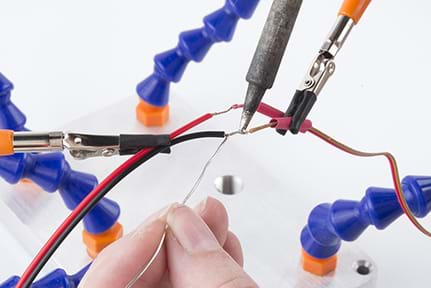
- After the solder is cool, direct students to slide the piece of shrink wrap over the exposed wire of the newly soldered wire connection and use a heat gun, or the edge of the soldering iron, to shrink it. If desired, have students use a longer piece of heat shrink over both wires to provide extra insulation and support. Repeat for all four connection points (two ends on each wire), as in Figure 8.
- As you oversee the student pairs working, ask them: Why do we use two wires to create the extension? (Answer: We must keep the complete circuit, one wire coming from the battery pack and one wire going towards it.)
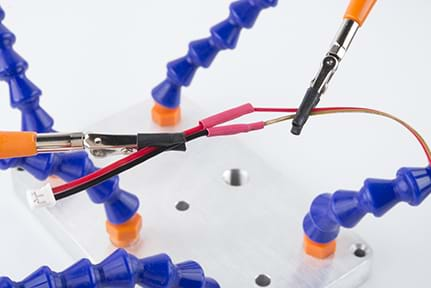
With the Students—Patch Installation/Attachment Methods
Tell students: Now it’s time to put the patch on something! Then direct the teams to position their patches on their items of choice and mark the locations for any holes that need to be cut to thread the cable through. Position the battery pack in an easily accessible place. Have students install or attach the EL panel patch using the method—ironing, sewing or pouch—that makes sense for the project and the resources available, as described below.
- Ironing Method: Once everything is in place, use a mini iron to adhere the edges of the iron-on patch material to the fabric of the clothing or bag, making sure to iron only the extended edges and not the panel itself (see Figure 9).
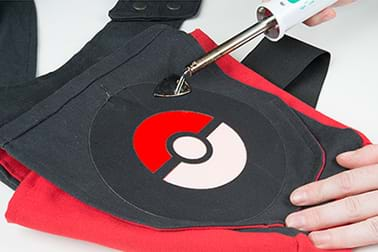
- Sewing Method: Alternatively, stitch the patches on by hand (Figure 10-left) or with a sewing machine—being mindful to not puncture the EL panel with the needle. In addition, decorative stitching (like in Figure 10-right) is a great way to customize the patch.
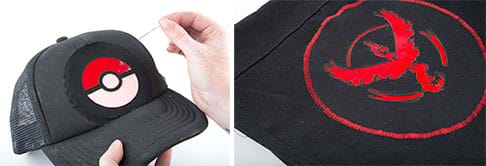
- Pouch Method: A third way is to make a pouch for the EL panel. This option is great for clothing items that might need frequent washing or to build in the flexibility be able to switch out the panel for a different design in the future. The Figure 11 example places the fabric stencil on a pocket and a plain EL panel is slipped inside the pocket to backlight the cutout stencil.
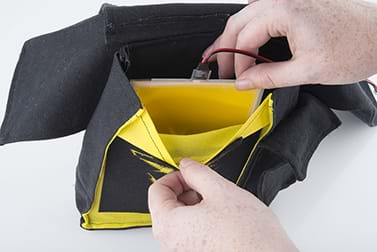
With the Students—Reinforcing the Connector Tab
- The small tab where wires extend from the EL panel can get damaged from frequent bending or pulling. To prevent the tab breaking or wires disconnecting, tell students to take special care in where they place the patch. Make sure that patch placement does not cause excessive wire twisting or turning and that the patch is close enough to the battery pack to prevent the wires from being stretched. After installing, have students add a small loop in the wiring to ease the wire strain on the connection point. As shown in Figure 12, make this wiring loop and secure it with either stitching, hot glue or to itself with electrical tape to prevent wire wear.
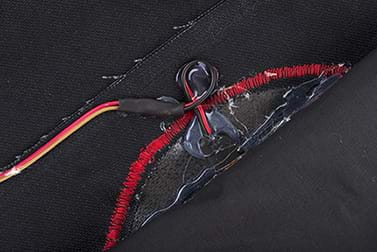
- As a final check, make sure that no exposed connections remain; see the Safety Issues section for a note about this. Once everything is secured, tell students to feed the cable through their projects and plug it into the battery back. Then light up, and enjoy!
With the Students—Conclusion
Conclude by conducting a class-wide product presentation, as described in the Assessment section.
Vocabulary/Definitions
EL panel: A flexible plastic sheet containing a phosphor layer that lights up when the correct voltage is applied. EL is short for electroluminescent.
Assessment
Pre-Activity Assessment
Engineering-for-Safety Discussion: To give context for the activity, lead a class discussion on how engineers work to improve human health and safety. Possible examples: self-stopping cars, crosswalk lighting systems, orange cones, warning systems, football helmets, air pollution monitoring systems, medical diagnostic equipment, replacement limbs, pacemakers, water treatment plants, sewage systems, GPS locator systems, etc.
Activity Embedded Assessment
Questions: As student pairs are fabricating their products, circulate the room. Ask them questions to check their depth of comprehension about what is going on. Make sure both students are engaged in each team project.
Post-Activity Assessment
Product Presentation: Have each group present its design to the rest of the class as if the audience is the parents from the hypothetical design challenge situation presented in the Introduction/Motivation section.
Safety Issues
- Remind students to be intentional and patient when using craft knives because they are very sharp.
- Heating irons and soldering irons are very hot so remind students to use these tools carefully so as to avoid burns.
- Although it is low current, EL wire runs on high voltage AC (100 VAC). Before wearing the glowing “safety products,” double check that no exposed connections exist on the wire or panel connection point. For final projects, it is recommended that any exposed connections be coated in epoxy, hot glue, electrical tape or other insulating material.
Troubleshooting Tips
If EL panels are too large for the desired projects (such as the baseball cap in Figure 10), use regular scissors to make them smaller or cut to specific shapes. After a panel is cut, seal the exposed edges with tape or epoxy so as to avoid shorting the panel or shocking yourself.
If ironing on the panel doesn’t work well (some iron-on adhesives are better than others), use glue to attach the fabric stencil.
Activity Scaling
For lower grades, pre-solder the wire extension together before the activity, and have only adults handle the iron, taking direction from students on patch placement.
Subscribe
Get the inside scoop on all things TeachEngineering such as new site features, curriculum updates, video releases, and more by signing up for our newsletter!References
Activity adapted from SparkFun’s Pokémon Go Patches with EL Panels tutorial at https://learn.sparkfun.com/tutorials/pokmon-go-patches-with-el-panels
"Engineering is essential to our health, happiness and safety." Engineers how are you changing the conversation? The Solution: Messages to Use. National Academy of Engineering. Accessed July 19, 2017. http://www.engineeringmessages.org/23673/28971/25296.aspx
Copyright
© 2017 by Regents of the University of Colorado; original © 2016 SparkFun EducationContributors
Angela Sheehan; Kent KurashimaSupporting Program
SparkFun EducationLast modified: August 8, 2025






User Comments & Tips